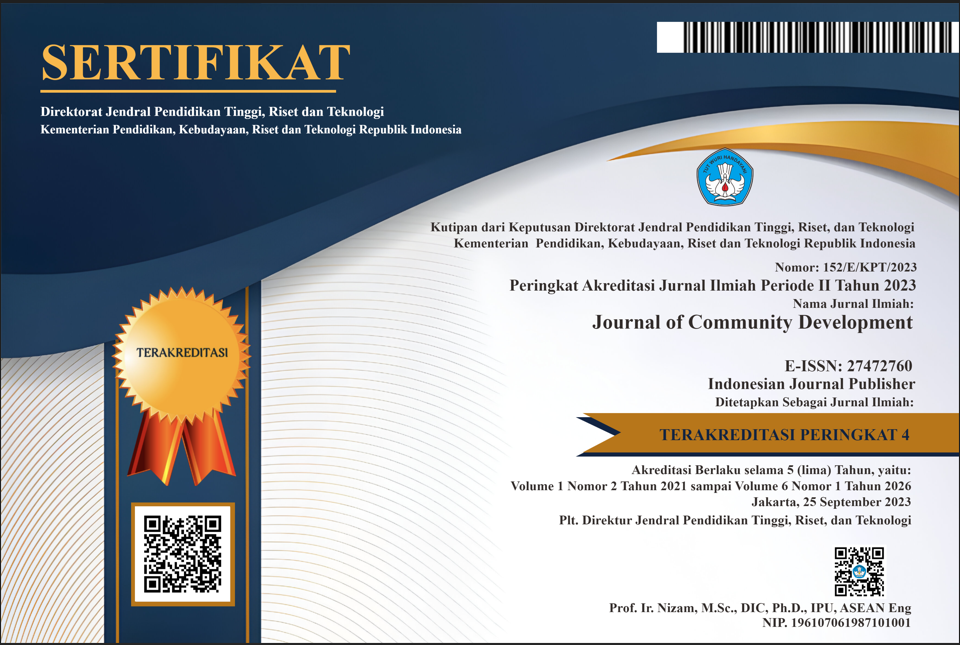Sosialisasi Penggunaan Aplikasi Pemantauan Kasus Stunting di Desa Kemuning Lor Kabupaten Jember
DOI:
https://doi.org/10.47134/comdev.v3i3.118Keywords:
android, nutrition, stuntingAbstract
In 2016, around 22.9% or 154.8 million children worldwide suffered from stunting at the age of under 5 years. Stunting is defined as the length or height below the standard. Stunting is measured by a z-score of height and age of more than 2 standard deviations which is below the World Health Organization (WHO) Child Growth Standards. Based on the results of observations on November 25, 2022 in Kemuning Lor Village, the community service team found that cadres and mothers could be said to be of productive age with an average of already having smartphones which were underutilized in monitoring the nutritional status of toddlers. In community service activities, an application was developed that is useful in reducing and monitoring the number of stunting cases in Kemuning Lor Village, Jember Regency. The implementation methods carried out in this community service activity are literature (literary study), location surveys, application design and outreach. As for the results of this community service activity, 90% of posyandu cadres feel helped by the baby nutrition monitoring application. In the future this application will be integrated from each region so that stunting cases in Jember Regency can be monitored through one application.
Downloads
References
Andarwulan (2020) ‘Penerapan Teknologi Deteksi Dini Stunting Sebagai Upaya Peningkatan Status Gizi Anak Di Kelurahan Siwalankerto Kecamatan Wonocolo Surabaya’, Jurnal Kesehatan Masyarakat Nasional, 1(3).
Candarmawen (2020) ‘The Challenges of preventing stunting in Indonesia in the new normal era through community engagement’, JKKI, 9.
Daeng, I. T. M., Mewengkang, N. . and Kalesaran, E. R. (2017) ‘Penggunaan Smartphone Dalam Menunjang Aktivitas Perkuliahan Oleh Mahasiswa Fispol Unsrat Manado’, e-journal acta diurna, VI(1), pp. 1–15.
Eny, P. (2015) ‘Double Burden Malnutrition Of Preschool Children And Its Association With Brain Development And Milk Consumption’, in. Bogor.
Kemenkes RI (2016) Peraturan Menteri Kesehatan Republik Indonesia Tentang Situasi Balita Pendek. Jakarta.
Kuntari et al. (2013) ‘Faktor Risiko Malnutrisi pada Balita’, Jurnal Kesehatan Masyarakat Nasional, pp. 572–576.
Rahmadhita K (2020) ‘Stunting problems and prevention’, Jurnal ilmiah kesehatan sandi husada.
UNICEF (2012) Maternal and Child Nutrition.
WHO (2018) Reducing stunting in children: equity considerations for achieving the Global Nutrition Targets 2025.
Wicaksno, A. P. and Mudiono, D. R. P. (2021) ‘Early Detection of Hepatitis by Using Certainty Factor’, 514(Icoship 2020), pp. 93–97. doi: 10.2991/assehr.k.210101.021.
Wicaksono, A. P. and Mudiono, D. R. P. (2019) ‘Expert System for Typhoid Fever Disease Diagnosis Using A Web-Based Application’, pp. 64–69. Available at:
https://publikasi.polije.ac.id/index.php/ProceedingICOFA/article/view/1805.
Downloads
Published
How to Cite
Issue
Section
License
Copyright (c) 2023 Demiawan Mudiono, Indah Muflihatin, Andri Permana Wicaksono

This work is licensed under a Creative Commons Attribution 4.0 International License.







